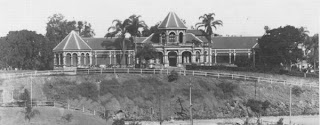By 1885 he was in business for himself, delivering coal with
a horse and dray. He extended his
interests to coal-transport on the Brisbane Bremer Rivers 17 May 1880 . His continuing good fortune and increasing wealth
enabled Black to buy 700 acres
(283ha) of coal deposits at Bundamba near Ipswich . There he established the Blackheath Colliery
and with electric haulage and advanced machinery was soon able to cut 600
tonnes a day – a State Record.
In 1892, Mr Black joined forces with the Wright Brothers
operations at the Eclipse Mine and was appointed as their Brisbane Coal Agent.
In 1896, Black took advantage of a strike in Newcastle Melbourne
Mr Black was becoming a significant player in Queensland
By 1900 the Bishop Mine was closed and the New Tivoli Mine
was the Wrights’ main operation with the Walloon site becoming a second
venture. The coal here was particularly
suitable for gas-making and so production was quickly raised.
In 1903, Black bought out the Wright Brothers interest
in the Caledonian Mine (Walloon) but relinquished his interest in Oakey there
he and raised the mines output to 300 tonnes a day. The
Caledonian Colliery continued mining until 1960.
Caledonian
Colliery (Thagoona/Walloon)
Next came his purchase of the Abermain Colliery
at North Ipswich which cost him an additional £8000 for a
railway-siding and £40 000 for a new shaft and machinery.
Abermain
Colliery (Tivoli
By 1910, Mr Black had installed electrical equipment into
his own Blackheath Mine including 7 coal-cutters with the electric plant for
driving them which had been installed.
Black employed other mechanical advances in his mine along with the
Aberdare, Rhondda and Box Flats mines, however these
initiatives were the exception rather than the rule and they do not seem to
have been adopted at any other mines.
Black retired from business in 1920. After his retirement, he spent some years
busily dispersing his fortune. Small,
dark, reserved and a devout Presbyterian anxious to maintain the link between
religion and education, he gave mainly to church institutions. He saw his wealth as a trust and believed
that “much had been given that by him, much might be done”; all his gifts were
carefully considered and were usually conditional on others agreeing to make
donations.
William
Robert Black
In 1917 he helped to establish Fairholme, the
Scots College for Boys (Warwick) Fairholme
College (Toowoomba)
From 1918 he served on the councils of both the Brisbane Boys’ College and Somerville House for Girls, a united educational venture by the Presbyterian Church in 1919-20 which then employed both a director and a kindergarten and primary supervisor of Sunday schools.
In 1923, Mr Black purchased a property in Oxley and donated
it to the Presbyterian Church for the establishment of the Blackheath Home for Boys.
Blackheath
Home for Boys
In 1927, Black
purchased the former home of Mr & Mrs John W Sutton at 7
Laurel Avenue
W.R.
Black Home for Girls
In 1929, he made two further donations to the Presbyterian
Church, Stonehaven Home for Aged Ladies at Twickenham
Street Cliveden
Avenue
Hopetoun
Hall, Cliveden
Avenue
During 1929 and 1930, Mr Black continued making many other
smaller donations to individual congregations which enabled the Presbyterian
Church in Queensland
Mr Black died of Coronary Thrombosis on 2 October 1930 at St
Martin ’s Hospital, Brisbane
St
Martins Hospital, Ann
Street , Brisbane
He had never married and, after various bequests to relations
in the Channel Islands , the residue of an estate valued
for probate at nearly £180 000 was left in trust for the Presbyterian Church in
Queensland
His black-marble tombstone, erected by the Church in Toowong
Cemetery, bears only the red hand of Ulster, a cross and two inscriptions: “Not slothful in business, fervent in spirit,
serving the Lord” and “The righteous showeth mercy and giveth”.
William
Robert Black at W.R. Black Home for Girls
William
Robert Black’s Black Marble Tombstone, Toowong Cemetery
In March 1978, the administrators of the now combined Scots
PGS College
“What courage it required to embrace this exciting future in
the darkest hour of the worst war the world had ever seen. The generosity of Presbyterian
philanthropist, Mr W.R. Black, made this physically possible.”
His name lives on in our history books!
Advertisement
















